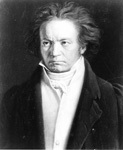• 1852 ~ Sir Charles Villiers Stanford, Irish composer and organist
• 1908 ~ David Oistrakh, Russian violinist
• 1922 ~ Oscar Pettiford, Bass, cello. He played with Charlie Barnet, Dizzy Gillespie, Duke Ellington, Woody Herman, and Stan Getz
• 1933 ~ The theme song was Hail, Hail, the Gang’s All Here and it opened the National Barn Dance. The half-hour country music and comedy show, originally heard on WLS, Chicago since 1924, moved to the NBC Blue network this night. National Barn Dance was broadcast from the Eighth Street Theater in Chicago, where the stage was transformed into a hayloft every Saturday night. The host was Joe Kelly. Uncle Ezra was played by Pat Barrett who was known to say, “Give me a toot on the tooter, Tommy,” as he started dancing. A few of the other Barn Dance characters were Arkie, the Arkansas Woodchopper; Pokey Martin; the Hoosier Hotshots; the Prairie Ramblers; cowgirl, Patsy Montana; Pat Buttram; Lulu Belle and the Cumberland Road Runners. Gene Autry and Red Foley were heard early in their careers on National Barn Dance. Although there were plenty of sponsors (Alka Seltzer, One-A-Day vitamins, Phillips Milk of Magnesia), the National Barn Dance was one of the few radio shows to charge admission!
• 1935 ~ Jill Corey (Norma Jean Speranza), Singer
• 1935 ~ Johnny Mathis, American singer of popular music
• 1935 ~ “Summertime … and the livin’ is easy.” Porgy and Bess was presented for the first time, at the Colonial Theatre in Boston. It was a flop! It was revived in 1942. It wasn’t a flop that time. It ran longer than any revival in the history of U.S. musical theater.
• 1941 ~ The Larry Clinton Orchestra recorded their version of That Solid Old Man, on Bluebird Records.
• 1942 ~ Frankie Lymon, Singer: recorded at age 14
• 1942 ~ Dewey Martin, Drummer, singer with Buffalo Springfield
• 1943 ~ Marilyn McCoo (Davis), Singer with The Fifth Dimension, TV hostess of Solid Gold from 1981 to 1984 and 1986 to 1988, TV music reporter
• 1946 ~ Sylvia Peterson, Singer with The Chiffons
• 1953 ~ Deborah Allen (Thurmond), Singer
• 1954 ~ Julie Andrews, who would later become a household name in movies, TV and on records, opened on Broadway for the first time. The future star of The Sound of Music appeared in The Boy Friend this night.
• 1976 ~ Mary Ford passed away
• 1977 ~ President Jimmy Carter designated October as the official country music month.
• 1979 ~ Clio-Danae Othoneou, Greek actress, musician and pianist
• 1989 ~ Virgil Thomson, US composer/critic (4 saints in 3 acts), died at the age of 92
• 2003 ~ Ronnie Dawson, the rock singer known as the “Blonde Bomber,” died. He was 64. Dawson was diagnosed in 2002 with throat cancer but continued to perform. One of his last gigs was an emotional performance at the Rockabilly Rave festival in England in February. He enthralled fans at the Big D Jamboree in the 1950s and at Carnegie Hall in the 1990s. Among Dawson’s songs as a teenager in the 1950s were Action Packed and I Make the Love. He was famous for live performances where he would jump from the stage, run through the audience and play his guitar while standing on a table. In the late 1950s, Dawson recast himself as an R&B artist named Snake Monroe, signed briefly with Columbia Records, and then joined the local Western swing pioneers the Light Crust Doughboys. In the 1960s, he packed the Levee Club with the Levee Singers, a folk act that appeared nationally on “The Danny Kaye Show” and “The Jimmy Dean Show.” After the Levee Singers broke up, he formed a country band, Steel Rail, and later sang television and radio jingles.
• 2003 ~ Robert LaMarchina, conductor of the Honolulu Symphony from 1967 to 1978, died. He was 75. Born in New York City, Robert LaMarchina began studying the cello at the age of 7. At 8, he made his first appearance as a solo cellist with the St. Louis Symphony. LaMarchina was 15 when famed conductor Arturo Toscanini hired him to perform with the NBC Symphony Orchestra. LaMarchina made is first appearance as a conductor in 1951 in Japan in the Fujiwara Opera’s production of “Madame Butterfly”. He later taught music at Indiana University, traveled with the Ambassadors of Opera and conducted operas on the West Coast.









 George Gershwin lived between September 26, 1898 and July 11, 1937. He is considered to be a twentieth century composer.
George Gershwin lived between September 26, 1898 and July 11, 1937. He is considered to be a twentieth century composer.